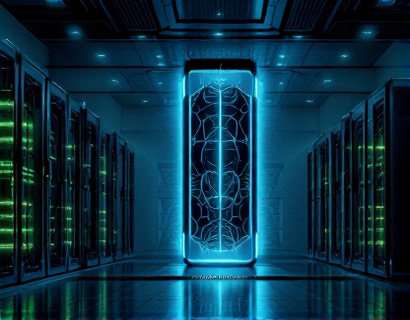Maximizing Token Value with Advanced Smart Contract Locking Solutions for Long-Term Incentives
In the rapidly evolving landscape of blockchain technology, investors and businesses are continually seeking innovative methods to enhance their investment strategies and secure their digital assets. One such approach gaining significant traction is the use of advanced smart contract locking solutions designed to lock tokens for long-term incentives. These solutions not only secure tokens but also maximize their utility and foster trust within the blockchain ecosystem. This article delves into the intricacies of these smart contract solutions, exploring how they can be leveraged to optimize investment potential and set a new standard in smart contract applications.
Understanding Token Locking for Long-Term Incentives
Token locking, in the context of blockchain, refers to the process of temporarily binding a certain amount of tokens in a smart contract, making them unavailable for transactions or transfers for a specified period. This mechanism is particularly useful for creating long-term incentives, where token holders can lock their assets to receive benefits such as increased voting rights, access to exclusive services, or enhanced returns on investment. By locking tokens, individuals and businesses can demonstrate their commitment to a project or platform, thereby gaining advantages that unlocked tokens cannot offer.
The primary goal of token locking is to align the interests of token holders with the success of the underlying project. When a significant number of tokens are locked, it signals confidence in the project's future, potentially driving up the token's value. This alignment of interests is crucial for the sustainability and growth of decentralized projects, as it reduces the risk of speculative trading and ensures a more stable token economy.
Advantages of Smart Contract Locking Solutions
Smart contract locking solutions offer several key advantages that traditional methods cannot match. First and foremost, they provide unparalleled security. Smart contracts are self-executing and reside on the blockchain, eliminating the risk of tampering or manipulation. This level of security is essential for token locking, as it ensures that the locked tokens remain safe and the incentives are delivered as promised.
Transparency is another significant benefit. All transactions and the status of locked tokens are recorded on the blockchain, making the process fully transparent to all participants. This transparency builds trust among users, as they can verify the integrity of the locking mechanism and the fulfillment of incentives. In an ecosystem where trust is paramount, this level of transparency is invaluable.
Moreover, smart contract locking solutions enhance token utility. By locking tokens, users can unlock additional features and benefits that are not available to unlocked tokens. For instance, locked tokens might grant access to premium services, higher staking rewards, or priority voting rights. These enhanced utilities make locked tokens more valuable and attractive, encouraging more users to participate in the locking mechanism.
Designing Effective Smart Contracts for Token Locking
Creating an effective smart contract for token locking involves several critical components. First, the smart contract must be robust and secure, with thorough auditing to identify and mitigate any potential vulnerabilities. Security is non-negotiable, as any flaw could lead to the loss of locked tokens or the misallocation of incentives.
Next, the smart contract should be user-friendly, providing a seamless experience for token holders to lock and unlock their assets. A well-designed user interface and clear documentation can significantly enhance user adoption and satisfaction. Additionally, the smart contract should be flexible, allowing for adjustments to locking periods, incentive structures, and other parameters as needed.
Another important aspect is the integration of governance mechanisms. Allowing token holders to participate in decision-making processes related to the locking mechanism ensures that the system remains decentralized and community-driven. This governance model can help in addressing concerns, implementing updates, and maintaining the project's long-term viability.
Case Studies and Real-World Applications
Several projects have successfully implemented advanced smart contract locking solutions to achieve their goals. One notable example is a decentralized finance (DeFi) platform that introduced a locking mechanism for its native token. Token holders who locked their tokens for a minimum period of six months were eligible for increased staking rewards and priority access to new features. The result was a significant increase in the token's locked supply, which in turn boosted the token's price and stability.
Another example is a blockchain-based social media platform that used token locking to incentivize content creators. Creators who locked a certain amount of tokens received exclusive moderation rights and a share of the platform's revenue. This approach not only secured the tokens but also aligned the interests of creators with the platform's success, leading to higher engagement and better content quality.
These case studies demonstrate the practical benefits of smart contract locking solutions. By providing clear incentives and ensuring security and transparency, these solutions can drive meaningful outcomes for both token holders and the broader ecosystem.
Challenges and Considerations
While the benefits of smart contract locking solutions are clear, there are several challenges and considerations that must be addressed. One major challenge is the technical complexity involved in designing and deploying secure and efficient smart contracts. Developers must have a deep understanding of blockchain technology and smart contract programming to avoid common pitfalls such as reentrancy attacks or gas optimization issues.
Another consideration is the user education aspect. Many potential users may be unfamiliar with smart contracts and blockchain technology, which can hinder adoption. Providing comprehensive educational resources and support is essential to overcome this barrier and ensure widespread participation.
Regulatory compliance is also a critical factor. As blockchain and token-based incentives become more prevalent, regulatory frameworks are evolving. Projects must stay informed about local and international regulations to ensure compliance and avoid legal issues. This may involve consulting with legal experts and adapting the smart contract design to meet regulatory requirements.
Future Trends and Innovations
The field of smart contract locking solutions is rapidly evolving, with several promising trends on the horizon. One such trend is the integration of advanced cryptographic techniques to enhance security further. For example, zero-knowledge proofs can be used to verify the status of locked tokens without revealing sensitive information, adding an extra layer of privacy and security.
Another area of innovation is the development of multi-asset locking solutions, where users can lock multiple types of tokens within a single smart contract. This approach simplifies the user experience and allows for more complex incentive structures, such as cross-chain token locking and interoperability between different blockchain ecosystems.
Furthermore, the rise of decentralized autonomous organizations (DAOs) is creating new opportunities for smart contract locking solutions. DAOs can utilize these solutions to manage governance tokens, ensuring that decision-making power is distributed fairly and securely among members. This can lead to more democratic and resilient organizational structures.
Conclusion
Advanced smart contract locking solutions represent a powerful tool for maximizing token value and fostering trust in the blockchain ecosystem. By securely locking tokens for long-term incentives, these solutions align the interests of token holders with the success of the underlying project, driving growth and stability. The advantages of enhanced security, transparency, and token utility make smart contract locking an attractive option for investors and businesses looking to optimize their investment strategies.
As the technology continues to evolve, we can expect even more innovative applications and integrations. Whether through improved security measures, user-friendly interfaces, or new governance models, smart contract locking solutions are poised to play a pivotal role in the future of blockchain technology. By embracing these advancements, the blockchain community can build more robust, trustworthy, and valuable ecosystems.










































